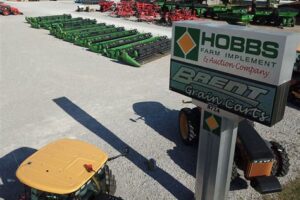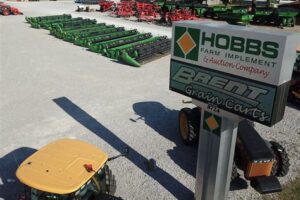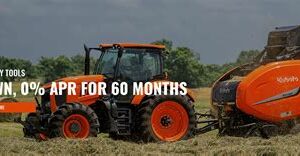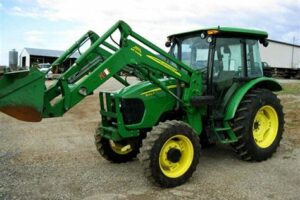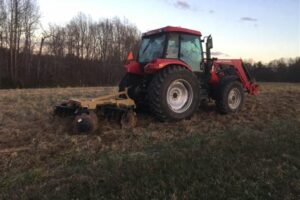Table of Contents
Learn about the different types of farm equipment used in agriculture. Discover the importance of tractors, harvesters, plows, and more. Explore how these machines enhance efficiency and productivity on the farm. Gain insights into the various tasks each equipment type is designed for, from planting to harvesting. Get a comprehensive understanding of modern farming technology and its impact on the industry.
When it comes to farming, having the right equipment is essential for success. From tractors and harvesters to plows and sprayers, there are various types of farm equipment that play a crucial role in the agricultural industry. Whether you are a seasoned farmer or just starting out, understanding the different types of farm equipment available can help you make informed decisions and optimize your operations. In this article, we will explore some of the most common types of farm equipment and the benefits they offer. So, let’s dive in and discover the tools that keep our farms thriving!
Farm Equipment Types
When it comes to modern agriculture, farm equipment plays a vital role in enhancing productivity and efficiency. From tractors to harvesters, there are various types of machinery designed to cater to the diverse needs of farmers. This article will explore some of the most common farm equipment types used in the industry today, highlighting their features and benefits.
Tractors
Tractors are the backbone of any farm operation, serving multiple purposes from plowing and tilling to hauling heavy loads. These powerful machines are equipped with a variety of attachments such as plows, harrows, and seeders, allowing farmers to efficiently prepare the soil for planting. With different horsepower options available, tractors can handle various tasks, making them an essential farm equipment type.
Combine Harvesters
Combine harvesters, often referred to as combines, are specialized machines designed to harvest crops such as wheat, corn, and soybeans. These self-propelled units can cut, thresh, and clean the grain in one operation, significantly reducing the labor required for harvesting. Combines are equipped with large headers that can efficiently gather crops, making them a valuable asset for large-scale farming operations.
Planters and Seeders
Planters and seeders are essential farm equipment used for sowing seeds into the soil. Planters are designed to place seeds at precise depths and intervals, ensuring optimal germination and plant growth. Seeders, on the other hand, are more commonly used for broadcasting seeds over larger areas. Both machines help farmers achieve consistent plant spacing and maximize crop yields.
Sprayers
Sprayers are farm equipment used to apply fertilizers, pesticides, and herbicides to crops. These machines come in various sizes and configurations, ranging from handheld sprayers to large, self-propelled units. Sprayers ensure even and accurate distribution of chemicals, helping farmers protect their crops from pests, diseases, and weeds while minimizing the environmental impact.
Balers
Balers are farm equipment used to compress and bundle crops such as hay, straw, or silage into manageable and transportable packages called bales. These machines come in different types, including round balers and square balers, each suited for specific crop types and bale sizes. Balers facilitate efficient storage and transportation of bulky crops, making them an essential tool for livestock feed production.
Mowers and Tedders
Mowers and tedders are farm equipment used for cutting and conditioning hay or forage crops. Mowers are designed to cut standing vegetation, while tedders help spread and turn the cut crop to enhance drying. These machines are crucial to ensure high-quality forage for livestock feed and facilitate efficient haymaking operations.
Plows
Plows have been used for centuries to prepare the soil for planting by turning it over and breaking up compacted layers. While modern farming practices have introduced more advanced tillage methods, plows are still widely used, especially in areas with heavy soil or during initial land preparation. Different types of plows, such as moldboard plows and chisel plows, are available to suit varying soil conditions and farming techniques.
Spreaders
Spreaders, also known as fertilizer spreaders or broadcasters, are farm equipment used to evenly distribute fertilizers, lime, or other soil amendments across the fields. These machines come in different designs, including broadcast spreaders and drop spreaders, allowing farmers to efficiently apply nutrients to their crops. Spreaders are essential for promoting healthy plant growth and optimizing crop yields.
Hay Rakes and Tedders
Hay rakes and tedders are farm equipment used for drying and gathering hay or forage crops. Hay rakes help arrange the cut crop into windrows, facilitating the drying process, while tedders further enhance drying by spreading and turning the hay. These machines help farmers produce high-quality forage with minimal loss and ensure efficient haymaking operations.
Cultivators
Cultivators are farm equipment used to control weeds and loosen the soil around growing crops. These machines come in various configurations, including row cultivators and field cultivators, each suited for different stages of crop growth and weed control needs. Cultivators help maintain soil moisture, improve nutrient uptake, and reduce competition from unwanted vegetation, contributing to higher crop yields.
In conclusion, the diverse range of farm equipment types available today empowers farmers to carry out their work more efficiently and effectively. Whether it’s tractors for soil preparation, combines for harvesting, or seeders for sowing, each machine plays a crucial role in ensuring successful agricultural operations. By leveraging the right farm equipment, farmers can maximize productivity, minimize labor requirements, and ultimately contribute to a sustainable and thriving farming industry.
Introduction
Farm equipment is a crucial component of modern agriculture, enabling farmers to efficiently carry out various tasks and maximize productivity. From planting to harvesting, there are numerous types of farm equipment available for different purposes. Tractors, harvesters, seeders, sprayers, balers, tillage equipment, irrigation systems, and livestock equipment are some of the key types of machinery used in farming operations. In this article, we will delve into each of these equipment types, highlighting their functions, features, and importance in the agricultural industry.
Tractors
Tractors are the backbone of farming operations, providing the power and versatility needed to perform a wide range of tasks. Equipped with large wheels or tracks, tractors are capable of navigating through diverse terrains with ease. Their attachment capabilities allow farmers to use various implements such as plows, planters, harvesters, and hay balers.
These powerful machines have revolutionized farming by significantly reducing labor requirements and increasing efficiency. Whether it’s plowing the fields, planting seeds, harvesting crops, or hauling heavy loads, tractors have become an indispensable tool on farms worldwide.
Harvesters
Harvesters, also known as combine harvesters, are specialized machines designed to streamline the crop harvesting process. These self-propelled units are capable of cutting and threshing the crop, separating the grain from the rest of the plant. The harvested grain is then stored in an onboard tank, eliminating the need for manual labor-intensive processes.
Harvesters are particularly useful for harvesting large-scale crops such as wheat, corn, and soybeans. Their ability to efficiently harvest and store the grain saves significant time and labor on the farm, allowing farmers to focus on other important tasks.
Seeders
Seeders, or seed drills, are essential farm equipment used for precise and controlled planting of seeds. These machines ensure even distribution of seeds across the field, ensuring proper spacing and depth for optimal germination. Seeders can be tractor-mounted or pull-behind, and they often feature adjustable settings to accommodate different seed types and field conditions.
By facilitating accurate and efficient seed placement, seeders contribute to higher crop yields and uniform plant growth. They also help farmers save time and reduce seed wastage by eliminating the need for manual seed dispersal.
Sprayers
Sprayers play a vital role in protecting crops from pests, diseases, and weeds. These agricultural tools are used to apply fertilizers, herbicides, and pesticides to crops. Sprayers utilize pumps, tanks, and nozzles to accurately distribute the desired substances across the fields.
By efficiently applying agrochemicals, sprayers prevent the loss of crops due to pest infestations and weed competition. They promote healthier plant growth, leading to higher yields and improved crop quality. Additionally, sprayers enable precise application, minimizing unnecessary chemical usage and reducing environmental impact.
Balers
Balers are indispensable in the hay and forage industry, where they compress and bind materials such as hay, straw, or corn stalks into uniform bales. These bales facilitate easy storage, transport, and handling of forage materials.
Agricultural balers come in various sizes and types, including round balers, square balers, and large square balers. Each type offers distinct advantages based on the specific requirements of the farmer. Balers not only improve efficiency but also help preserve the nutritional value of forage materials, ensuring high-quality feed for livestock during periods of scarcity.
Tillage Equipment
Tillage equipment is used to prepare the soil for planting or weed control. Primary tillage tools such as plows, cultivators, and disk harrows are employed to break up the soil and incorporate organic matter. Secondary tillage equipment like rotary tillers or field cultivators create a finer seedbed and remove weeds before planting.
By effectively preparing the soil, tillage equipment promotes better root development, nutrient absorption, and seed germination. It also helps control weeds, which compete with crops for resources. Proper tillage practices contribute to improved soil structure, water retention, and overall crop productivity.
Irrigation Systems
Irrigation systems are essential in areas where rainfall is inadequate to meet the water requirements of crops. These systems deliver water directly to the plants’ root zones, ensuring optimal hydration and promoting growth and productivity.
Sprinklers, drip irrigation systems, and center pivots are commonly used irrigation equipment. Sprinklers distribute water through overhead sprinkler heads, while drip irrigation systems provide water directly to the plants’ roots. Center pivots rotate around a central pivot point, irrigating large areas of farmland.
By efficiently managing water resources, irrigation systems reduce water wastage and enable farmers to cultivate crops in regions prone to drought or limited rainfall. They play a crucial role in ensuring continuous agricultural production and food security.
Livestock Equipment
Farm equipment is not limited to machinery for crop-related tasks; it also includes equipment for livestock management. Livestock equipment encompasses feeding and watering systems, as well as facilities like chutes and corrals for handling and managing animals.
Proper livestock equipment is vital for ensuring the well-being and efficient management of animals on the farm. It helps minimize stress during handling, provides adequate nutrition and hydration, and supports disease control measures. Livestock equipment contributes to the overall productivity and profitability of livestock operations.
Conclusion
Farm equipment types are diverse and essential for modern agricultural practices. Tractors, harvesters, seeders, sprayers, balers, tillage equipment, irrigation systems, and livestock equipment all play critical roles in maximizing farm productivity, reducing labor requirements, and ensuring efficient crop and livestock management.
By utilizing these advanced machinery and tools, farmers can enhance their operations, increase yields, and contribute to sustainable and profitable farming practices. The continuous advancements in farm equipment technology further drive innovation in the agricultural industry, enabling farmers to meet the challenges of feeding a growing global population while minimizing environmental impact.
When it comes to farming, having the right equipment is crucial for success. With the advancements in technology, there are now various types of farm equipment available that can greatly improve efficiency and productivity on the field. In this article, we will explore some of the most common types of farm equipment and their benefits.
1. Tractors
Tractors are perhaps the most essential piece of farm equipment. They are versatile machines that can be used for a wide range of tasks such as plowing, planting, harvesting, and hauling. Tractors come in different sizes and horsepower options to suit the specific needs of each farmer. They are equipped with various attachments and implements, making them highly adaptable to different agricultural activities.
2. Harvesters
Harvesters are designed to efficiently harvest crops such as grains, fruits, and vegetables. These machines automate the process of cutting, threshing, and separating the crop from the plant. They can significantly reduce labor requirements and speed up the harvesting process, especially for large-scale operations. Harvesters are equipped with advanced technologies that ensure minimal crop loss and high-quality produce.
3. Planters and Seeders
Planters and seeders are specialized machines that are used for sowing seeds or planting seedlings in the field. They ensure precise seed placement at the desired depth and spacing, which is crucial for proper crop development. These machines save time and effort compared to manual planting methods. Planters and seeders also come with features like fertilizer applicators, which help in providing the necessary nutrients to the crops during the planting process.
4. Sprayers
Sprayers are essential for crop protection and pest control. They are used to apply fertilizers, herbicides, and pesticides to the crops. Sprayers ensure even distribution of these substances, reducing the risk of crop damage and maximizing their effectiveness. Modern sprayers are equipped with advanced technologies that allow for precise application rates and minimize environmental impact.
5. Irrigation Systems
Irrigation is crucial for maintaining optimal soil moisture levels and ensuring proper crop growth. Irrigation systems range from simple sprinklers to more advanced drip irrigation systems. These systems help conserve water by delivering it directly to the roots of the plants. They can be automated and controlled remotely, allowing farmers to efficiently manage water usage and ensure uniform irrigation across the field.
6. Balers
Balers are used to compress and bundle hay, straw, and other crops into compact bales for storage or transportation. They greatly simplify the process of handling and storing bulky materials. Balers come in different sizes and configurations, catering to the specific needs of farmers. They can significantly reduce labor requirements and protect the harvested crops from spoilage.
In conclusion, the right farm equipment can greatly enhance productivity, efficiency, and profitability in agriculture. Tractors, harvesters, planters and seeders, sprayers, irrigation systems, and balers are just a few examples of the wide range of specialized equipment available to farmers. Investing in modern farm equipment is essential for staying competitive in today’s agricultural industry.
Thank you for visiting our blog and taking the time to learn about the various types of farm equipment. We hope that this article has provided you with valuable insights into the different tools and machinery used in modern agriculture. As you can see, there is a wide range of equipment available, each serving a specific purpose and contributing to the overall efficiency and productivity of farms.
One of the most common types of farm equipment discussed in this article is tractors. These versatile machines are essential for a wide range of tasks, from tilling the soil and planting crops to harvesting and hauling heavy loads. Tractors come in various sizes and power capacities, allowing farmers to choose the one that best suits their needs. Whether you have a small-scale farm or a large operation, investing in a reliable tractor is crucial for maximizing productivity.
In addition to tractors, there are numerous other types of specialized farm equipment available, such as combines, planters, sprayers, and harvesters. Each of these machines plays a crucial role in different stages of the farming process, making it more efficient and less labor-intensive. For example, combines are used to harvest grain crops, while planters ensure accurate seed placement for optimal crop growth. By using these specialized tools, farmers can save time and resources, ultimately increasing their yield and profitability.
As technology continues to advance, so does the farm equipment industry. Precision agriculture has become increasingly popular, with the integration of GPS and other advanced technologies into farm machinery. These innovations allow farmers to precisely monitor and control various aspects of their operations, such as seed and fertilizer application, irrigation, and yield mapping. By harnessing the power of technology, farmers can optimize their production and minimize waste, resulting in more sustainable and environmentally friendly practices.
We hope that this article has given you a comprehensive overview of the different types of farm equipment available today. Whether you are a seasoned farmer or just starting in the field of agriculture, understanding the purpose and functionality of these tools is crucial for running a successful and efficient farm. By investing in the right equipment and staying up to date with the latest advancements, you can ensure that your farm operates at its full potential. Thank you once again for visiting our blog, and we look forward to sharing more valuable insights with you in the future.
Video Farm Equipment Types
People also ask about Farm Equipment Types:
-
What are the different types of farm equipment?
There are various types of farm equipment used for different agricultural activities. Some common types include:
- Tractors
- Harvesters
- Planters
- Sprayers
- Tillage equipment
- Hay balers
- Seeders
- Spreaders
-
What is a tractor used for?
A tractor is a versatile farm equipment used for various tasks, such as plowing, tilling, planting, and harvesting. It provides the necessary power to pull or push heavy implements and perform tasks efficiently.
-
What is a harvester used for?
A harvester, also known as a combine harvester, is used to harvest crops like wheat, corn, soybeans, and rice. It can cut, thresh, and clean the grains in a single operation, significantly reducing manual labor.
-
What is a planter used for?
A planter is a farm equipment used to sow seeds into the soil at specific intervals and depths. It ensures uniform seed placement, which promotes optimal crop growth and yield.
-
What is a sprayer used for?
A sprayer is used to apply pesticides, herbicides, fertilizers, and other chemicals to crops. It ensures efficient and even distribution of these substances, helping to protect crops from pests, diseases, and weeds.
-
What is tillage equipment used for?
Tillage equipment is used to prepare the soil for planting by breaking up compacted soil, removing weeds, and creating a suitable seedbed. It includes plows, cultivators, and disk harrows.
-
What is a hay baler used for?
A hay baler is used to compress and bale hay or straw into compact forms for easy storage and transportation. It helps preserve the nutritional value of the forage and minimizes wastage.
-
What is a seeder used for?
A seeder is a farm equipment used to sow seeds directly into the soil without the need for prior seedbed preparation. It is commonly used for planting grass, cover crops, and small grains.
-
What is a spreader used for?
A spreader is used to evenly distribute fertilizers, lime, or other soil amendments across a field. It ensures that these substances are applied in the correct amounts and helps enhance soil fertility.
These are just a few examples of the farm equipment types available for different agricultural needs. The choice of equipment depends on factors such as the type of crop, farm size, and specific farming practices.

